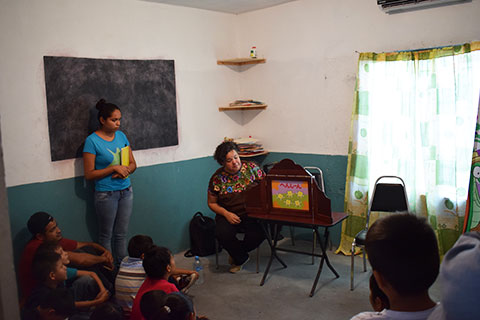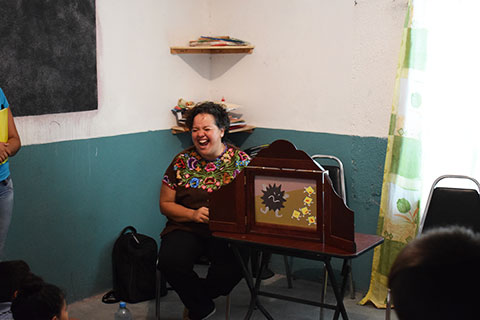
Tell us about yourself, your childhood, overall background, and current occupation.
I love stories. Wherever I am in the world, my favorite places are libraries. I love so much to see children's books. In Japan, my favorite place in the library was the children area with so many kamishibai stories and also the manga section.
In my home, growing up, I had so many books and encyclopedias. I especially love fairy tales, and my favorite book is Hans Christian Andersens's Stories.
I studied for a degree in Communications Sciences in Querétaro, and my dream was to write the most beautiful stories. I love my current occupation, because everyday, I read and tell stories to children and teenagers. I am a Storyteller. And today my dream is the same.
How did you first find out about kamishibai?
I saw a Japanese woman tell stories with big cards in the University, where I studied Japanese. I was curious because the images were very good. And when I read a book about manga, I discovered kamishibai, and I wanted to know more and have the cards. I was looking at the Internet and found Kamishibai de Navarra. I studied as much as I could about kamishibai, and I found the page of Pepe Cabana and the name of IKAJA (The International Kamishibai Association of Japan). I looked into it and became a member of IKAJA. I also saw the Kamishibai for Kids website, and I studied the information about kamishibai.
What made you want to start performing kamishibai?
I am a storyteller, and I love Japanese culture. I was completely in love with the beautiful cards.
Do you make your own stages? How do you use the stage in performance?
A carpenter friend makes my stages. I studied about educational kamishibai, and I use the stage regularly in this form. But I also like the informality of the gaito kamishibaiya (street performance artists). And sometimes when the audience is very big, like 300 children, I prefer to make a more informal presentation.
How do you develop your stories?
I adapt traditional Mexican folktales and tales of the world. Sometimes my stories are inspired by published picture books, illustrated by other authors. And I sometimes use origami to illustrate my stories. I would like to make adaptations of Andersen's stories to the kamishibai format.
Do you have a favorite story or kind of story?
Yes, I prefer the stories with a lot of participation from the audience. I was so happy with them. And I like the stories about peace or transcendental themes.
Whom do you see as your audience for kamishibai?
Everyone. I tell stories for families, teenagers, college students, people with disabilities, elderly people, and babies of one year old.
What do you think kamishibai offers this audience and what has their response been when you have performed?
Kamishibai offers a connection with the image, and you can listen to the performer and enjoy the story. Sometimes when the performer is very expressive you can feel the image, you can understand because they help you understand the story with tone of voice, expression, this is special when you do not speak the same language.
When you speak the same language as the audience, I think the most special time is the kyokan (sense of shared emotion) you can feel with them.
The most beautiful response for me with an adult audience was in Chile, I told kamishibai stories in Viña del Mar for university students, and they enjoyed the stories for children. I had the attention and participation of the entire audience.

How is kamishibai similar to and/or different from other storytelling forms that are available to you in your country?
Sometimes teachers tell me that they like to make stories on a big roll of paper, and they found it to be very similar with kamishibai.
I think the kamishibai is different and has special features, such as the stage, big images, dialogues, and the sense of kyokan. And when the performer decides to give protagonism to the story.
What are your plans going forward for performing kamishibai or making them available to others?
I want more people to know about kamishibai because I want them to make their own stories. I think it is very easy for children to make a good story with kamishibai. And they can learn about storyboarding, reading, working in teams, illustration, and speaking in public. And I learn about children when they create stories and tell their stories to the public.
I want to give more workshops for teachers and children. I want more people around the world and Mexico to share the stories of kamishibai. My goal is to work in Mexico with indigenous people, because I want to record children's stories and stories of the elderly.
I originally studied journalism, but in my country, journalism is very dangerous work. I want to write and draw kamishibai to protest these conditions because I want things to change. I want people to have their own voices to tell others about their problems and possible solutions they have. I want to use kamishibai for this because I want a country with peace and more security for woman, young men, and children. I don't believe in mass communication. I think the more powerful message is the one you share with them person-to-person.
Is there anything else you would like to add?
This year, I directed the 5th International Kamishibai and Storytellers Festival Alal 2017 in México. The name of the festival means "baby" and is chosen each year from a different indigenous language. So far, the festival names have been Konetl I (Náhuatl), Ne'Ne II (Tsotsil), Chaanpal III (Maya), Cha lee IV (Mixteco) and Alal V (Tseltal). The Festival's objective is to introduce kamishibai and to tell stories that help children and teenagers find answers to their important questions, and also to dream and experience happy moments. We want to promote a culture of peace and strengthen ties of friendship between countries. We have the vision to be a Festival that has positive impact in the community in Mexico.
Facebook (personal): https://www.facebook.com/Terenokamishibai/
Facebook (International Kamishibai Festival): https://www.facebook.com/FIKNOBB/
Video: https://www.youtube.com/watch?v=mMiyP-NoK9M (Cuento del Conejo y el Coyote)
Linkedin: https://www.youtube.com/watch?v=DPtMRCTFVRU






